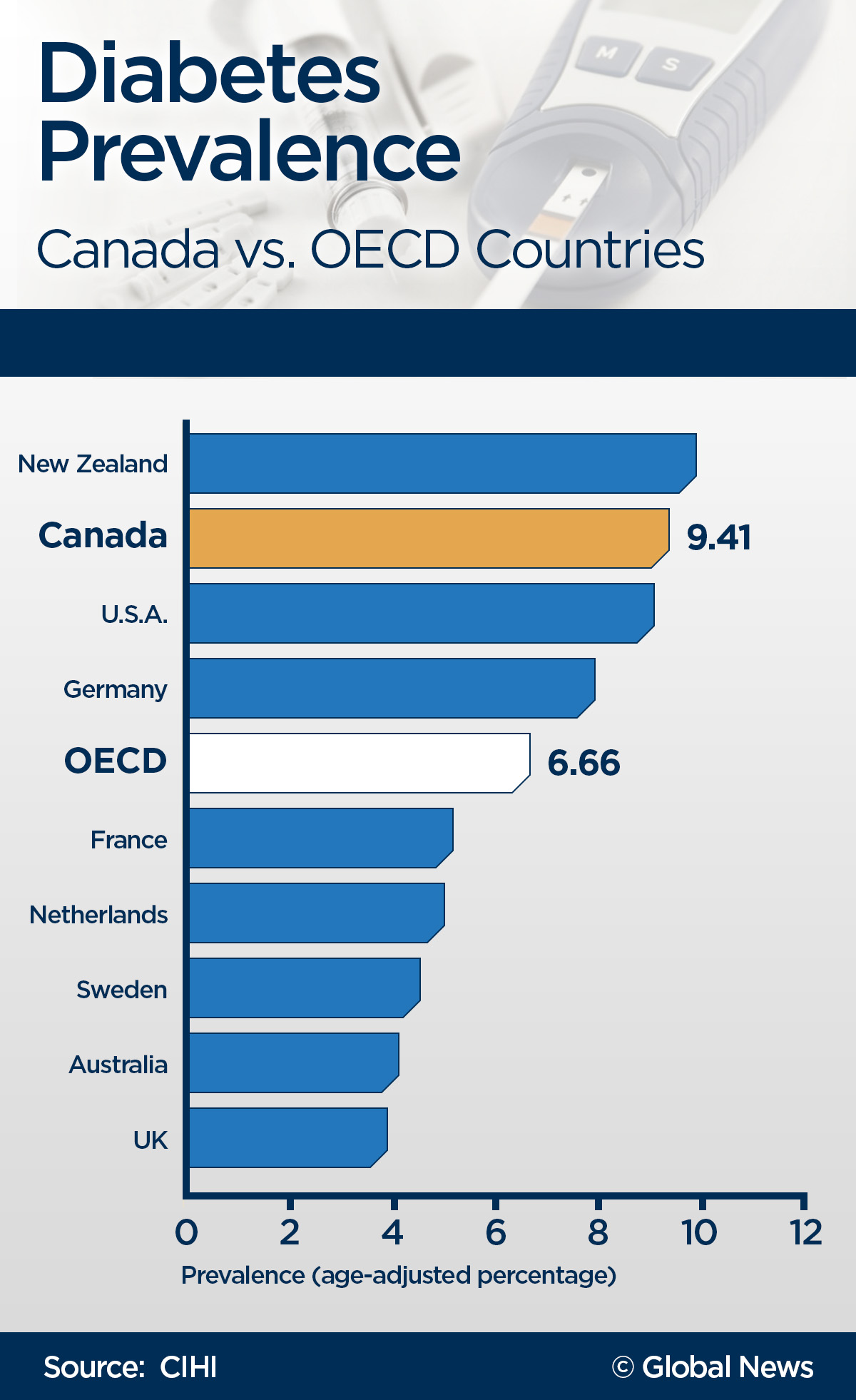Tracey Ruiz was a busy working mother, eating on the go, drinking lots of cola and taking care of everyone and everything before herself – then at 42 she was diagnosed with type 2 diabetes.

“Humongous wake up call. I mean, I was young, I was only 42. You don’t think it’s going to be you and you have all the time in the world,” Ruiz told Global News.
Ruiz is one of millions of Canadians who suffer from diabetes and the numbers are rising.
The prevalence of diabetes in Canada is now slightly higher than in the United States. In fact, among the 34 Organization for Economic Cooperation and Development (OECD) countries, Canada is higher than all other countries except New Zealand. That means Canada is the second worst.
According to the Canadian Institute for Health Information’s (CIHI) report, International Comparisons: A Focus on Diabetes, just over nine percent of Canadians have diabetes, that’s more than three million Canadians living with diabetes.
“Diabetes is the epidemic of our time along with the obesity epidemic,” Dr. Ronald Goldenberg told Global News. Goldenberg is an endocrinologist at LMC Diabetes and Endocrinology.
- Bird flu risk to humans an ‘enormous concern,’ WHO says. Here’s what to know
- Shoppers faces proposed class action over claims company is ‘abusive’ to pharmacists
- ‘Bacterial vampirism’: Deadly pathogens attracted to human blood, study finds
- Most Canadian youth visit dentists, but lack of insurance a barrier
Obesity and type 2 diabetes go hand-in-hand so it’s often called “diabesity.”
READ MORE: Three-year-old among youngest ever to be diagnosed with Type 2 diabetes
Close to 90 per cent of people with diabetes have type 2 diabetes, according to the Canadian Diabetes Association. The vast majority of type 2 diagnoses could have been avoided or delayed with healthy eating and leading an active life.
In addition, 5.7 million Canadians have pre-diabetes – that means they are not diabetic yet – they can turn it around if they tackle it now.
“There is great research and quite a few clinical trials that show intensive lifestyle changes can prevent the progression from pre-diabetes to type 2 diabetes. These lifestyle changes are not that difficult to institute. We’re talking about five per cent reduction in your body weight, 150 minutes of a brisk activity every week, that’s 30 minutes five times a week, along with healthier nutrition choices, and just by doing that you can reduce your chances of converting from pre-diabetes to diabetes by 60 per cent,” Goldenberg said.
The CIHI report did say Canadians and the health care system are succeeding in the area of diabetes treatment. Dr. Goldenberg told Global News that Canada has “tremendous practice guidelines” for treatment and there have been important advancements in oral therapies, but we also need to focus on prevention.
CIHI also has an online tool that allows Canadian to compare provincial health care to other OECD countries, OECD Interactive Tool: International Comparisons
Prevention strategies are needed
CIHI believes a multi-pronged approach is required to tackle the problem.
The Canadian Diabetes Association agrees. “With high rates of overweight and obesity in Canada, there is a need for better food environments overall in our country,” said Dr. Jan Hux, chief science officer at the CDA. “The CDA would also like to see ethical and accurate nutrition information provided to consumers and greater access to healthy and affordable food options, especially in communities where there is a higher risk of diabetes.”
Complications from diabetes can include – chronic kidney disease, foot problems, non-traumatic lower limb amputation, eye disease that can lead to blindness, heart attack, stroke, anxiety, and nerve damage, according to CDA.
When Ruiz was diagnosed she weighed 250 pounds, since then she has changed her life – she has lost 85 pounds, she works more reasonable hours and exercises regularly. She knows her obesity played a role in her diagnosis. She admits there have been ups and downs, but she had excellent support and an attentive physician. Ruiz works as a sleep doula helping children, and she’s also learned to help herself.
“Eating healthy makes such a big difference,” said Ruiz, “if I wanted to see my kids grow up, I needed to start taking care of me.”






Comments